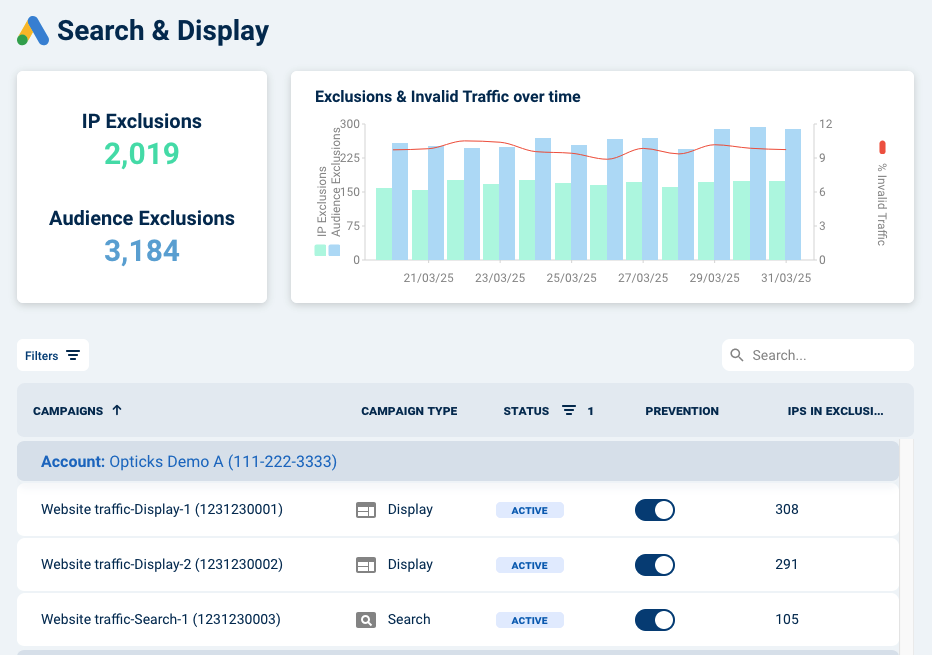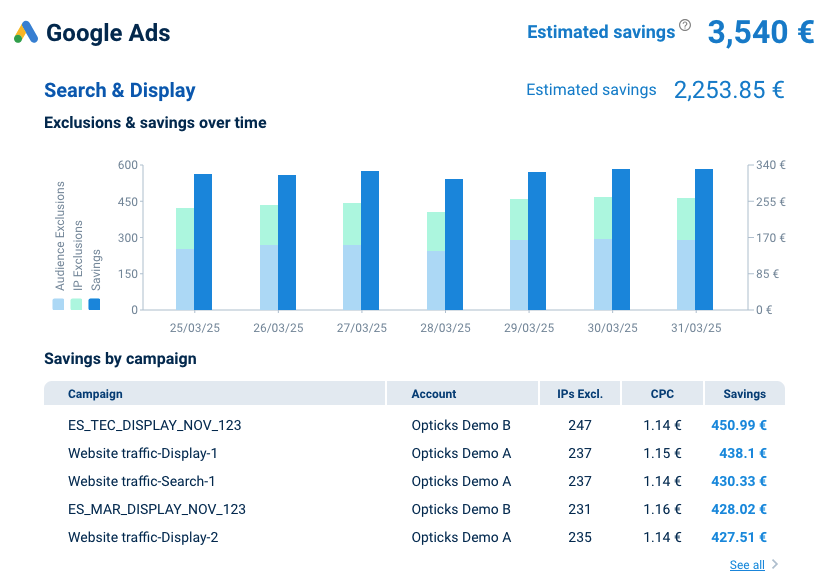Opticks prevention in Google Ads
Fraud prevention for Google Ads must occur before the user is sent to the landing page by using the exclusions provided by Google Ads, specifically IP Exclusions and Audience Exclusions.
In this context, fraud prevention happens before the user is acquired, protecting the Google Ads budget of Opticks's clients. For a user to be excluded (either by IP or audience exclusion), the initial invalid click must first occur.
IP exclusion as prevention method
To prevent wasting the advertising budget on fraudulent visits, IP addresses can be excluded at the campaign level in Google Ads. This exclusion applies to both Search and Display campaigns. Additionally, Google Ads allows the creation of an IP exclusion list at the account level, which can be used by all campaigns within the account.
However, there are limitations: a maximum of 500 IPs can be excluded per campaign, and a total of up to 500 IPs can be excluded across the entire account at any given time.
To adapt to these limitations, Opticks uses an algorithm to identify and prioritize the IPs that most negatively impact our clients' marketing efforts. This ensures that the most harmful IPs are excluded first, maximizing the effectiveness of the exclusions within the allowed limits. The IPs are kept for a 15 days window. If during that timeframe they are not seen again, they are discarded to allow for new IPs to be excluded.
In summary, Opticks categorizes IPs into four layers, starting with manually excluded IPs and ending with the Global Intelligence Layer. This last layer utilizes Opticks' general fraud intelligence to preventively assist advertisers who may not have enough fraudulent traffic volume to fill up the 500 IP exclusions.
Audience exclusion as a prevention method
In cases where IP exclusions aren't available for a specific campaign type, preventing fraudulent activity through audience exclusion becomes the solution. When Opticks is linked to our clients' Google Ads accounts, it sets up and maintains an audience within the account. This audience is automatically populated with fraudulent users identified by Opticks.
One advantage of using audiences is that there's no size limit, unlike the 500 IP limit. However, audiences do require a minimum size to function effectively, typically around 1000 users. Audiences are a potent tool because they are used to train the targeting algorithm of your campaigns rather than affecting a particular set of users (like IP exclusion does).
Opticks negative audience will be automatically applied to all Search and Display campaigns that have prevention enabled. However, it must be manually enabled in Performance Max campaigns as automation via API is not available.

Savings (Economic Impact)
Opticks shows a metric called “Savings” in several sections of the application. This metric is an approximation of the economic impact of invalid traffic that has been handled by Opticks. It is calculated using both IP and audience exclusions, and updated on a daily basis with the data of the previous day.
Economic impact of IP exclusions
The formula Opticks uses to calculate the economic impact of IP exclusions is complex as it varies depending on the Campaign type and the IP exclusion layer, but can be simplified to the following for each Google Ads campaign:
Number of IP exclusions * Average CPC * 1.6
That 1.6 is what Opticks call the “repetition factor”. It is the average number of invalid clicks by IP in Google Ads and it is calculated on a period basis using all the clicks analyzed by Opticks in that period, so it can be slightly modified over time. Therefore, the simplified formula means that if Opticks has excluded 100 IP’s on a particular day on a campaign with an average CPC of 0.50€, the associated economic impact of invalid traffic is 80€.
Economic impact of audience exclusions
The formula Opticks uses to calculate the economic impact of audience exclusions is similar to the IP exclusions:
Number of user exclusions * Average CPC * 1.6 * 0.02
It adds an extra correction factor of 0.02 which is used to represent the technical limitations and the “black box” mechanism that audiences are in platforms such as Google Ads. Opticks can only attempt to exclude the user, and it is up to Google and their system to decide whether they are able to exclude the user or not in an audience based on the data available at that point by Google. It is also unable to send feedback to Opticks in real time, so the relationship between users excluded by Opticks and users actually excluded by Google is not straightforward.
Therefore, after correlating our numbers with the size of audiences, we apply a conservative approach of estimating that to be 2% (0.02) of the users.

For more information about any particular topic, please look at the Opticks knowledge database or get in touch with us at support@optickssecurity.com